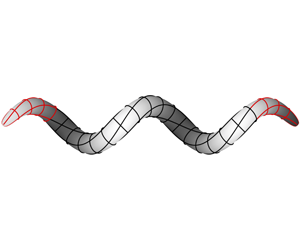Published online by Cambridge University Press: 09 July 2020

Artificial microswimmers, or ‘microbots’, have the potential to revolutionise non-invasive medicine and microfluidics. Microbots that are powered by self-phoretic mechanisms, such as Janus particles, often harness a solute fuel in their environment. Traditionally, self-phoretic particles are point like, but slender phoretic rods have become an increasingly prevalent design. While there has been substantial interest in creating efficient asymptotic theories for slender phoretic rods, hitherto such theories have been restricted to straight rods with axisymmetric patterning. However, modern manufacturing methods will soon allow fabrication of slender phoretic filaments with complex three-dimensional shapes. In this paper, we develop a slender body theory for the solute of self-diffusiophoretic filaments of arbitrary three-dimensional shape and patterning. We demonstrate analytically that, unlike other slender body theories, first-order azimuthal variations arising from curvature and confinement can make a leading-order contribution to the swimming kinematics.